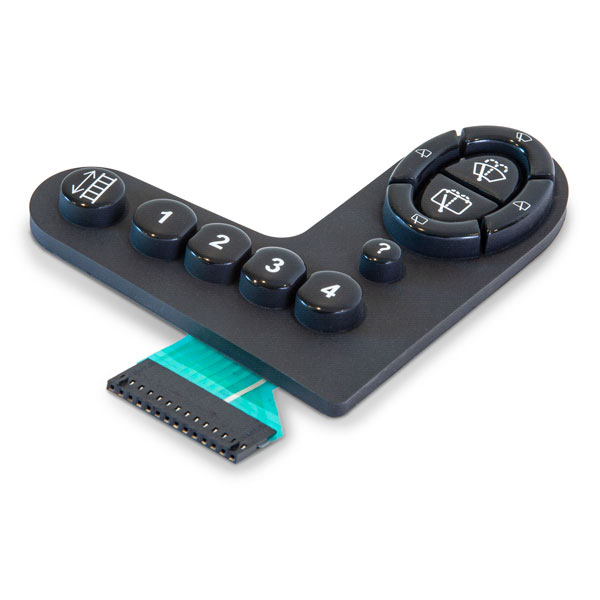Explore the Benefits of Using a Membrane Switch in Modern Devices
Explore the Benefits of Using a Membrane Switch in Modern Devices
Blog Article
Understanding Membrane Switches: The Trick to Dependable and resilient Controls

What Are Membrane Switches?
Membrane switches are an advanced solution in the world of individual interface technology, combining performance and style perfectly. These devices function as an interface between customers and digital systems, incorporating numerous elements right into a portable format. Generally constructed from adaptable, slim layers of materials, membrane switches are made to react to touch, allowing users to interact with equipment and electronic gadgets efficiently.
The key components of a membrane button include a printed circuit layer, visuals overlay, and a spacer layer that prevents unplanned activation. The graphic overlay can be customized to reflect brand name identification or user preferences, boosting appearances while making sure usability. Membrane buttons are commonly used in numerous applications, consisting of medical gadgets, consumer electronic devices, and commercial equipment, owing to their longevity and resistance to environmental factors such as dampness and dust.
One of the key advantages of membrane buttons is their capability to stand up to wear and tear, making them optimal for high-traffic atmospheres. In addition, they are light-weight and require marginal room, permitting for innovative layouts in product growth. In general, membrane switches represent a practical and reliable option for modern-day digital interfaces, weding modern technology with user-centric design principles.
How Membrane Switches Over Work
The operation of membrane switches hinges on a basic yet effective device that equates user input into electronic signals. When a customer presses the button, the top layer warps, enabling a conductive aspect in the circuit layer to make contact with an equivalent conductive pad on the bottom of the graphic overlay.
The layout of membrane buttons can vary, yet they often include domes or tactile aspects to offer feedback to the user, improving the general experience - membrane switch. The products utilized in membrane switches, such as polyester or polycarbonate, add to their longevity and resistance to ecological factors, including moisture and dirt. Additionally, the printed circuits are typically enveloped, which protects them from damage with time.
Benefits of Membrane Layer Buttons

Furthermore, membrane layer switches are known for their longevity. Created from robust materials, they are resistant to dust, wetness, and physical wear, which substantially expands their life-span contrasted to conventional mechanical buttons. This longevity makes them specifically ideal for high-traffic settings and applications calling for long life.
One more considerable advantage is the convenience of cleansing and maintenance. The smooth surface of membrane switches minimizes dirt build-up and is usually unsusceptible spills, making them perfect for settings that require constant sanitization.
Additionally, membrane buttons offer a streamlined profile, bring about a thinner layout that can be incorporated into various tools without adding mass. This attribute not only enhances the visual charm however additionally adds to a much more ergonomic product layout.
Applications of Membrane Layer Switches
Versatile and straightforward, membrane layer switches locate applications throughout a wide range of sectors, consisting of clinical tools, customer electronic devices, and commercial equipment. In the medical area, these switches are indispensable to devices such as analysis devices, client monitoring systems, and mixture pumps, where reliability and convenience of cleaning are critical. Their capacity to maintain and stand up to harsh settings functionality makes them perfect for such applications.

In customer electronic devices, membrane switches are made use of in products like microwaves, cleaning machines, and push-button controls - membrane switch. Their streamlined design enables instinctive user interfaces, improving the total user experience while supplying sturdiness and resistance to tear and wear
Industrial devices additionally takes advantage of membrane switches, specifically in control panels for equipment and automation systems. These switches provide security versus dirt and moisture, making sure regular efficiency in challenging environments. Moreover, their customizable features allow makers to customize them to details functional demands, enhancing efficiency and performance.
Selecting the Right Membrane Change
When selecting a membrane switch, it is vital to think about different elements that influence performance and suitability for specific applications. The primary factors to consider consist of ecological conditions, tactile feedback, resilience, and design specifications.
First, assess the operating setting; buttons subjected to moisture, chemicals, or extreme temperature levels call for certain materials to ensure long life and performance. Next, examine the need for responsive feedback. Depending on user communication, some applications might click reference take advantage of a tactile feedback to validate activation, while others may favor a non-tactile style for visual factors.
Toughness is one more crucial variable; membrane buttons must be created to stand up to frequent usage, view it now impacts, and abrasion. Make certain the chosen button can endure the anticipated lifecycle, especially in high-usage circumstances.

Conclusion
In conclusion, membrane changes offer as essential elements in the design of long lasting and reliable control systems across various markets. The convenience of membrane layer changes permits for tailored services that satisfy details functional needs, reinforcing their relevance in modern technology.
Membrane switches represent an essential facet of modern interface design, mixing functionality with resilience in various applications.Membrane switches are an advanced option in the realm of individual interface innovation, incorporating capability and layout flawlessly. Typically constructed from flexible, slim layers of products, membrane switches are developed to respond to touch, enabling users to interact with equipment and electronic devices effectively.
The design of membrane layer buttons can differ, however they typically integrate domes or responsive aspects to supply comments to the user, enhancing the total experience.In verdict, membrane layer changes serve as necessary elements in the design of durable and reliable control systems across various industries.
Report this page